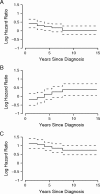Time-varying effects of prognostic factors associated with disease-free survival in breast cancer
- PMID: 19403844
- PMCID: PMC2733768
- DOI: 10.1093/aje/kwp077
Time-varying effects of prognostic factors associated with disease-free survival in breast cancer
Abstract
Early detection and effective treatments have dramatically improved breast cancer survivorship, yet the risk of relapse persists even 15 years after the initial diagnosis. It is important to identify prognostic factors for late breast cancer events. The authors investigated time-varying effects of tumor characteristics on breast-cancer-free survival using data on 3,088 breast cancer survivors from 4 US states who participated in a randomized dietary intervention trial in 1995-2006, with maximum follow-up through 15 years (median, 9 years). A piecewise constant penalized spline approach incorporating time-varying coefficients was adopted, allowing for deviations from the proportional hazards assumption. This method is more flexible than standard approaches, provides direct estimates of hazard ratios across time intervals, and is computationally tractable. Having a stage II or III tumor was associated with a 3-fold higher hazard of breast cancer than having a stage I tumor during the first 2.5 years after diagnosis; this hazard ratio decreased to 2.1 after 7.7 years, but higher tumor stage remained a significant risk factor. Similar diminishing effects were found for poorly differentiated tumors. Interestingly, having a positive estrogen receptor status was protective up to 4 years after diagnosis but detrimental after 7.7 years (hazard ratio = 1.5). These results emphasize the importance of careful statistical modeling allowing for possibly time-dependent effects in long-term survivorship studies.
Figures

References
-
- Esteva FJ, Sahin AA, Cristofanilli M, et al. Molecular prognostic factors for breast cancer metastasis and survival. Semin Radiat Oncol. 2002;12(4):319–328. - PubMed
-
- Early Breast Cancer Trialists’ Collaborative Group (EBCTCG) Effects of chemotherapy and hormonal therapy for early breast cancer on recurrence and 15-year survival: an overview of the randomised trials. Lancet. 2005;365(9472):1687–1717. - PubMed
-
- American Cancer Society. Cancer Facts and Figures. Atlanta, GA: American Cancer Society; 2007.
-
- Gray RJ. Flexible methods for analyzing survival data using splines, with application to breast cancer prognosis. J Am Stat Assoc. 1992;87:942–951.
Publication types
MeSH terms
Grants and funding
LinkOut - more resources
Full Text Sources
Medical

